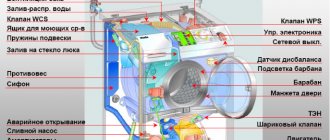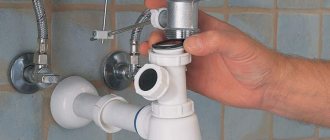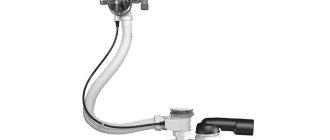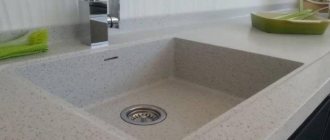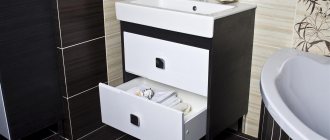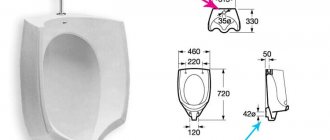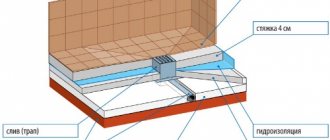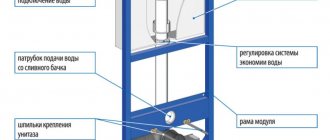The simplest option for draining water is a hose installed on the edge of the sink or bathtub. Unsightliness and the need to clean the bathtub after each wash, plus high humidity in the bathroom or kitchen, are not in favor of this method. In addition, due to circumstances, the drain hose may fall out of the bathtub or sink, and cause expensive repairs to the neighbors’ apartment on the lower floor. A siphon for a washing machine is a reliable and proven way to connect the unit to a drain or sewer system.
Purpose
Many people believe that the main purpose of the siphon, which is used to connect a washing machine, is to drain water. But this device is also intended for other purposes:
- The siphon ensures proper operation of the sewer system using a water barrier. This allows you to forget about unpleasant odors in the room where the machine is installed. Many consumers don't pay attention to this feature until sewer odors enter their home. Replacing the siphon will help solve the problem.
- The device collects all small debris and parts that enter the system during washing and prevents them from entering the sewer pipes. The siphon allows you to prevent clogging of the sewer system, since regular cleaning of pipes is quite problematic. Sometimes it is simply impossible to use chemicals to clean pipes, since the material of the pipes itself can be damaged. Some models of washing machines have a separate compartment that collects all the dust, wool and small objects. But if the model does not have this storage device, then the main load goes entirely to the siphon.
- To facilitate the operation of the washing machine pump , bends in the drain hose are used.
Checking the functionality of the equipment
When checking equipment, you need to pay attention to the following aspects:
- all fasteners must be tightened as tightly as possible;
- if the hoses have seams and joints, there should be no gaps between them;
- where the siphon connects to the drain hole, all bolts and nuts must be tightened especially tightly, because this is where leaks most often form.
In order to identify leaks, you should use toilet paper or paper napkins. The paper is placed at the seams and joints. Next, the washing machine starts. If the paper is wet in some places, it means it is leaking, and to solve this problem you need to tighten all the fasteners more tightly.
Kinds
The presence of a siphon ensures good drainage of water, extends the life of the washing machine and helps to avoid possible problems that arise from sewer blockages.
Choosing a suitable siphon is quite simple, since there are only two types of this device on the plumbing equipment market.
Combined
Use in any room. It allows water to be drained from the sink, and an additional pipe ensures a reliable connection of the automatic machine to the sewer system.
Related article: Correct joining of parquet boards and tiles
Separate (external and built-in)
- A separate siphon is often used to connect an automatic washing machine. It can be external or built-in.
- The external siphon is characterized by small dimensions, but requires more space than the built-in element, which makes it difficult to install the machine near the wall. It is attached to the sewer pipe using an O-ring.
- a built-in siphon “boxed”; it requires less space than an external one. It is completely hidden in the wall, only an invisible pipe remains. Using the built-in siphon, you can install the washing machine tightly to the wall. Installation of this device is very simple, but you only need to prepare a special recess in the wall in advance. This variety is in great demand among buyers, because it carries out a hidden automatic discharge of water from the machine. First, the walls are tiled, and then the siphon is installed in the recess.
Testing connected equipment
Upon completion of work related to installing the siphon and connecting the washing machine, you should check the quality of all connections and their tightness. First, you can check how tightly all the bolts, nuts, clamps and other elements are tightened.
It is very important that the rubber gaskets lie flat in the holes, ensuring an even seal around the entire circumference.
To ensure reliable sealing when connecting the siphon, rubber O-rings are used. Make sure that these seals are placed evenly at the joints.
Then turn on the washing machine and select a washing mode to fill it with enough water. After this, the mode is changed so that the device drains the water. You can put a layer of dry paper towels or toilet paper at the joints.
This will allow you to detect even a small leak during operation of the device. If a combined siphon is used for connection, in the kitchen or bathroom, at the same time as draining the water from the machine, you should turn on the water at maximum flow in order to test the siphon under increased load.
The nuances of connecting a washing machine to the drain
Before purchasing a certain machine model, you must first read the instructions in the instructions to determine what water pressure should be to operate the product.
If the apartment is located on the upper floors, then it is necessary to check that the height difference and the storage tank can create the required pressure. On the lower floors this problem is completely absent.
Sometimes difficulties arise when connecting an automatic machine to a drain due to its location.
There are several connection methods:
- directly to the bath;
- to the siphon, which is located under the sink or sink;
- to the sewer pipe.
To connect the machine directly to the bathtub, only a hose is used, as well as a holder on the side of the bathtub. These devices are sold complete with equipment.
To connect a siphon for draining an automatic machine to a sink, you need to purchase a model with a special pipe. To connect to the pipe, a hose from the machine is connected and secured with seals.
The last mounting option, which is made to a sewer pipe, is more complex, but is also often used.
When connecting the machine to the siphon, you should pay attention to two nuances:
- The drain must be connected at a height of about 60 cm to reduce the load on the functioning of the pump.
- It is not recommended to extend the drain hose so as not to create additional stress on the pumping system. If the length is not enough, then this problem can be solved by using an additional sewer tube, the diameter of which will be only 3.2 cm. First, the pump will push water through the hose, and then it will flow randomly through the additional tube. If you decide to extend the hose, be sure to secure it at the required height, rather than throwing it on the floor, and make the right angle for good water drainage.
Related article: Decorative curtain for a doorway - new trends in the interior
Types
There are four types of siphons - combined, external, built-in and with a check valve. Each has its own pros and cons.
Combined
The part is combined with an outlet that is installed under the sink or bathtub. Options with two outlets are possible. A standard model found in almost every home.
Outer
An external drain conduit connected exclusively to the outlet of the washing machine.
Built-in
A special feature of the built-in, or hidden, type is its appearance - from the outside, the L-shaped pipe looks like a decorative element. It goes well with the bathroom; it can be mounted under plaster or tiles by slightly punching the wall.
With check valve
A good option in case the water from the tank returns back. This type of siphon is called a dry siphon because it blocks the return of water to the tank. Inside the check valve there is a spring with a ball at the end. After draining the water, it seals the hole and prevents water from flowing back from the sewer. More details in this article:
How to install an anti-siphon for a washing machine, when is it necessary and how to do it yourself
Installation steps
Connection to sewer pipes occurs in several stages and depends on the material of the pipes.
If the sewerage system consists of cast iron pipes, you must:
- Remove the old siphon. Fasten a special rubber adapter to the pipe, which will allow you to connect the cast iron to the plastic.
- Use a special plastic adapter, which has the shape of an oblique tee with a diameter of 5 cm.
- Insert the rubber adapter, the dimensions of which are 5x2.4 cm, and install the drain hose.
If plastic pipes are used for sewerage in the house, the connection process is greatly simplified. It is only necessary to build in the tee, and then all the actions are performed, as when attaching an automatic machine to cast iron pipes.
Preparing to purchase fittings
To organize an effective washing process, you can use any type of siphon. The main thing is to take into account ease of installation, use and aesthetic qualities. If the washing machine is located far from the siphon, and saving space is not an issue, then you can buy any type of siphon.
It is ideal when the drain fittings are hidden from view by something - a bathtub, sink, door, furniture, or any other object. If the shape of the siphon “hurts the eye”, does not add aesthetics to the room, and there is no way to hide it, then you need to purchase a built-in product.
This solution will allow you to place the washing machine close to any wall the owner needs and hide the drain fittings. This option will significantly improve the appearance of the room.
A combined siphon is the most universal solution, as it allows you to connect any number of drain hoses to the sewer pipe
When you plan to install it under a water lily sink, then it would be correct to purchase a flat siphon. It takes up a minimal amount of space, so you can easily accomplish your plans.
If a potential buyer plans to drain contaminated water from 2-3 types of equipment simultaneously, then the optimal solution would be to purchase a combined siphon that has the required number of fittings for connecting drain hoses.
If there is no check valve in the design of the washing machine, you should not save money on its purchase. The owner will not regularly benefit from it, but in a critical situation this product will save you from significant troubles and losses.
A flat siphon is the best option when the owner of a washing machine needs to save space in the bathroom or other room
There is no need to skimp on the quality of the siphon itself or its components. Since their service life is always relatively short, and budget options remain operational for an even shorter period of time.
What to consider during installation, additional details
When purchasing a washing machine, the kit already includes a hose, the length of which is usually 3 m, but sometimes it is 5 m. If the length of the hose is not enough, then it can be extended, but not more than 3 m, and be sure to use a polypropylene pipe with a diameter of 2 cm for connection. It’s better not to extend it, but to buy a new hose of the required length. The special pump, which is responsible for draining water from the washing machine, is one of the most expensive parts in a washing machine, so it makes sense to save it. The longer the hose, the greater the load on the pump, so its service life is reduced. Also, in an extended hose, the number of blockages in narrowing areas increases.
When installing a washing machine, two additional details must be taken into account:
- The shut-off valve is responsible for shutting off the water so that it does not flow back into the machine. Usually washing machines come with this part, but if there is no valve, then you should definitely buy one. The importance of a regular valve is that once it is closed, the water can be used for other needs. Without it, there is a high possibility of flooding the room.
- The self-tapping valve does not shut off the water. It should be installed only in cases where there are no other units connected to the riser that use water and can cause pressure drops in the water supply system.
Related article: Leveling the floor with plywood: how to level old logs, concrete sheathing and wooden screed using plywood
Theory
What is it needed for
During washing, the siphon processes the water that comes from the tank to drain through the drain hose. There are at least three more functions, the absence of which you will definitely feel:
- The device creates a water seal - a water plug between the bathroom and unpleasant odors from the sewer. The plug blocks the desired area in the pipe along its entire diameter, hermetically closing the passage of foul-smelling gases, even when the machine does not drain the water.
- At the same time, the spare part practically eliminates traffic jams in the system itself - and if a problem does occur, it allows you to easily fix it. Some models filter out large debris - coins, receipts, pins, buttons, rings, hairballs. This reduces the likelihood of sewer blockages to zero and helps to find the loss.
- The siphon reduces the load on the pump, which keeps the part in working condition much longer.
Often the drain hose is connected directly to the sewer or other drains - to the bathroom, sink or toilet. Connecting like this all the time is useless and dangerous:
- The hose will not create a water seal on its own; the pipe will have to be bent into an S or U shape.
- If you connect the hose directly to the sewer, you will not get rid of odors, and the corrugated casing will quickly become unusable under stress.
- The resulting “pump” often has to be expanded, because a sealing plug is not created in short pipes. This increases the load on the hose, and a leak may begin at the attachment point.
In general, the hose should only be used directly for short periods of time and in extreme cases. It is much safer and quieter to install a siphon.
Which one is better to choose?
The most popular brands are Bonomini, McAlpine, ITAP (ITAP), TECE, Alcaplast, Geberit, Grohe, RBM, Viega and ANI Plast. There is no clear solution for choosing a siphon. You can only compare each of the proposed types and choose a more suitable option for your apartment. We will discuss all types below.
Features of connecting to the sink
To connect the machine to the sink, the hose should be located at a height of about 60 cm to prevent the possibility of water accidentally flowing back into the machine.
It is necessary to purchase a tee, the shape of which resembles the letter “U”, then a hose from technical equipment is installed in one hole, and in the second - for the sink. Don't forget to use a sealant when connecting the machine to the tee. Only correct connection guarantees excellent washing without interruptions.
How to install a siphon
First you need to make sure that all components have no visible damage or defects; be sure to look at the threads of the connections. Before installation, it is necessary to arrange all the elements in the order in which they will be attached.
Prepare screwdrivers, oilcloth, plastic tape, a set of gaskets, a rag, and a bucket. To completely protect yourself from leaks at the joints, use expensive silicone sealant. If it is necessary to dismantle the old system, then remove the siphon and the sewer pipe connected to it. Next, carefully inspect the coupling, in case of defects, replace it with a new one, clean the socket of dirt and old sealant applied.
A metal rim is connected to the upper hole of the bathtub, to which a pipe is attached. Then a siphon is connected to the drain hole located at the bottom of the bathroom, and it is screwed on using a drum. When the assembly is complete, take the other end of the corrugation and attach it to the sewer pipe. It is important not to lose rubber bands, seals and other small parts. After checking all connections for leaks, you can start using the bathroom. When installing, you should also thoroughly tighten all the nuts; they are usually plastic and must be tightened by hand. Before installing sealing gaskets, they must be carefully coated with a layer of sealant. Particular attention should be paid to the junction of the siphon with the bathtub, the main leak forms there, do not skimp on the sealant and tighten the bolts better.
Subtleties of choosing siphons
A small variety of siphons greatly simplifies the process of choosing a product, but still, special attention should be paid to some points:
- The country of origin directly affects the quality of the product.
- The material used to make the siphon, and the conditions in the room in which the washing machine will be installed.
- If the machine will be installed in the kitchen along with other equipment that consumes water, for example, a dishwasher or coffee machine, then the siphon must have several outlets.
- The siphon system must be solid, without cracks or other defects. Particular attention should be paid to the threads of all connections. All rubber gaskets must be the same size as the pipes.
- The technical parameters of the siphon should be decisive when choosing a siphon. Wear-resistant material guarantees a long service life and proper operation of the entire system. The best materials for making a siphon are stainless steel or polyethylene.
On what principle does a siphon work?
A siphon with an outlet to the washing machine operates similarly to a sewer siphon:
- When water is drained, it is retained in the sump due to the special shape of the device.
- The penetration of sewer gases is prevented by the resulting hydraulic seal - a blocking water plug that does not allow gases to pass out.
Good to know: The spiral shape of a small built-in siphon increases the resistance of the water seal.
In mass production, a device for a washing machine for the sink is very often found. It has a fairly simple design, consisting of an outlet made on the receiving pipe of the drain unit. It can be with a threaded end for a nut or a regular end for a hose. When connecting the washing machine, only this one part will need to be replaced, without reconstructions or alterations in the room.
Sink siphon with outlet is connected to the washing machine
Guidelines for choosing a device
Selecting drain fittings is difficult only because of the low awareness of potential buyers with this type of equipment. But it’s not difficult to fix this, since there are only a few types of it, which greatly simplifies the task.
The following video will introduce you to the typical types of siphons used when connecting washing machines:
These include the following siphons:
Since each type has its own advantages and disadvantages, an interested person should familiarize himself with them in more detail. This will help save time and money when purchasing.
Inexpensive and extremely unsightly
Typically, external siphons are used if the washing machine and the nearest sewer pipe are separated by a fairly large distance. This makes it possible to install in a convenient place and use for this purpose structurally simple products that are not distinguished by compactness or other technical delights.
The disadvantages include the fact that external siphons do not make it possible to install existing washing machines close to the walls a person needs. Therefore, in some cases, insufficient compactness can also be considered a disadvantage.
Convenient and inexpensive models
A feature of all internal siphons is their small dimensions and the fact that they are mounted inside the wall, for which special recesses are made. The above allows you to install washing machines close to any wall of the room.
In addition, internal siphons are distinguished by high aesthetic qualities. Their body is recessed into a pre-made cavity, and the outer part is covered with a decorative panel, which can be metal or plastic. Therefore, of the entire structure, only the compact fitting, bent at 90 °C, can be seen.
The disadvantages of internal siphons are the relatively complex installation and considerable cost, compared to other types. In addition, they are much more difficult to dismantle, which causes some inconvenience when cleaning is necessary.
Universal combined option
Visually combined siphons do not differ from ordinary ones, with the exception of just one point. This is the presence in the design of several fittings intended for the simultaneous connection of drain hoses belonging to different objects.
This product is versatile, therefore it is used to simultaneously drain contaminated water from washing machines, washbasins, kitchen sinks, and dishwashers.
How to install a combined siphon is described in the following video, and it also shows the advantages and disadvantages of this method of connecting to the sewer:
Differences in size and shape
For ease of use, all modern drain fittings differ in shape and size. This is done to ensure the required performance, efficiency, prevention of clogging, ease of installation, providing sufficient aesthetic qualities, and solving other issues.
Therefore, if a potential buyer needs to save space when installing a washing machine, then he should pay attention to flat siphons. They have the most compact dimensions.
As a result, they make it easy to place the purchased washing machine under the existing washbasin sink. Which is an effective solution, especially in small bathrooms. This type of installation can be an interesting design solution if a person chooses a matching appliance and sink.
Devices with check valves
Although modern siphons successfully resist clogging and the formation of traffic jams, anything can happen. Therefore, the buyer should take care of an additional degree of protection.
For these purposes, a siphon for a purchased washing machine with a built-in check valve is used. It is designed to solve a number of important tasks to ensure safe use.
Which include:
- Preventing the return of contaminated water when plugs form in sewer pipes.
- Elimination of unauthorized drainage of water during the washing process.
The presence of this valve is especially important for residents of the lower floors of houses. Since they suffer the most from clogged sewer systems.
Siphons: main purpose
Siphons are needed not only to protect premises from unpleasant odors.
Such devices have much more functions:
- Simplifying the operation of the water pump. After all, a hose that is quite long is used.
- Cleaning as necessary will not cause difficulties, because access to the insides is easy and simple.
- The hydrosizer is the main part that prevents the appearance of unpleasant odors and additional noise.
- Protection against various harmful microorganisms.
If there is no siphon, then car owners have additional problems.
If you hang the drain hose at a certain height in a curved form, you can partially cope with the troubles. But in this case, you cannot do without additional extension. And the height will need to be sufficient, at least 500 millimeters above the floor. Such solutions do not always look attractive in existing interiors.
How is installation done?
Automatic washing machines are expensive types of equipment. Therefore, you must strictly follow the manufacturer's instructions when installing. The higher the cost of the product, the more expensive the repair will be later.
Installing siphons with outlet
Siphons have an appearance much like regular sinks. The only difference lies in the absence of a separate pipe to which the machine is connected. The installation also has a standard scheme, which is used in almost all bathrooms. Sometimes they only change the tube with the fitting, and not the siphon itself, but such options cannot be considered acceptable.
The description of the process will be as follows:
- We remove the old device completely. For this purpose, two plastic nuts are unscrewed, which are responsible for fastening to the drain and other parts. The main thing is not to forget to place a container where dirty water flows.
- The drainage of the sink into the sewer is thoroughly cleaned. Dirt and deposits must be completely removed.
- We install a new siphon. The main thing is to remember to screw the plastic nuts tightly when the work is almost finished.
- We put the hose from the machine on the fitting, which is intended for this.
- The connection is tightened to ensure maximum tightness.
About installing built-in products
The main thing is to think in advance about how the washing machine connects to the sewer. Special siphons for water drainage are built in if the equipment has its own permanent place. The installed product is completely covered using moisture-resistant plasterboard. There should be a tile on top. Only a small outlet should be left outside, through which the hose is connected.
Putting on the nut or tightening it are simple but effective ways to complete the fastening. These types of siphons have the main advantage of maintaining a small distance between the machines and the walls. The connections themselves have an attractive appearance.
Thanks to siphons, pumps are protected from additional loads. Provides complete protection from harmful effects from the sewerage system.
Getting ready for further use
Before starting to work with the product, it is recommended to carefully inspect all components. This will allow you to identify existing defects and defects in advance. The main thing is to take a closer look at the threaded connections.
After this, you can choose the place where the equipment will be installed. We also need to decide on the method of laying communications. It is necessary to take into account the features of a particular siphon model so that the work is done correctly. All that remains is to choose the appropriate tools and additional materials.
Installation and some features
A sink or countertop can hold sinks that operate with an overflow. The main thing is to know in advance where and how the machine itself will be located.
- The location is exactly under the sink. Then siphons built into walls or flat ones are suitable. All that remains is to screw them to the drain near the sink. The corrugated hose is inserted into one of the outlets. The other end of this device should already be directed into the sewer pipe. The drain hose of the washing machine is connected to the second outlet; fastening involves the use of a clamp. This completes the installation.
wall-mounted siphon
- Under the countertop, to the left or right of the sink. In such situations, it is allowed to use any siphons equipped with outlets for sinks. But this is only theoretical. You just need to take into account that the space under the sink remains open. This means that an outside visitor will easily notice the complete design of the siphon. Another reason to choose wall-mounted varieties.
- The washing machine is located at a considerable distance from the sink, under a long countertop. This arrangement also implies the possibility of using any siphon. All that remains is to make sure that the appearance of the room does not suffer too much. But there is one additional feature that needs to be taken into account. After all, the washing machine is located quite far from the sink. Therefore, the standard drain hose may not be long enough. You will have to buy an extended device. It is this variety that replaces the standard one.
Choice by shape and size
The complexity and speed of its installation depends on the shape and size of the model. Manufacturers have developed models that, regardless of their shape, provide a water seal to any plumbing fixture.
For a small bathroom, it is recommended to connect the washing machine to a flat siphon. They free up extra centimeters of space. A flat siphon apparatus together with a washing machine is mounted under the sink. If you choose a sink model, such a tandem will decorate a small bathroom.
Connection option using a tee
Installation in the absence of water pipes near the connection area is possible by installing a “tee”
You need to position the tee so that the hose can easily be connected to it, and the washing does not interfere with it. We recommend purchasing tees with a hydraulic lock, which can shut off the water if something happens. It is strictly not recommended to make such an insertion at the beginning and end of the pipe; it is best to insert the tee in another area.
Note! To carry out this manipulation, it is necessary to completely drain the riser. In some cases, to carry out this step you will need to contact your housing office. If you are not confident in your abilities, the best solution would be to call a specialist who will do everything quickly and efficiently. You can find it on the Internet or contact the same housing office.
After completing all procedures, do not forget to screw the drain hose to the washing unit.
